This is a work in progress. It will continue to be edited and updated as needed.
Last update: July 13, 2016
This dictionary is an attempt to create a standardized vocabulary for use when discussing contemporary competitive jousting. It is based not only on historical sources(which can vary greatly depending on time and place), but also on modern websites that deal with jousting, and discussions held between jousters/crew on social networking sites and at tournaments.
If you have suggestions for words/phrases to add to the dictionary, changes to existing definitions and/or other ways to improve this page, please email The Jousting Life. If you have a question about a word/phrase(either on this list or not), feel free to email TJL and ask about it.
Arçon: a traditional French word for the front part of a saddle, in English it's generally called the 'Pommel'.
Armour: the protective clothing worn by the jouster and sometimes the horse during jousting. It is usually metal, but occasionally leather or other materials are used depending on the type of jousting being done.
Arret and Grapper: The 'Arret' is a sort of hook attached to the breastplate of jousting armour for the base of the lance to rest upon. (Some breastplates include an arret and some do not.) The 'Grapper' is a sort of tight ring attached to the base of the lance just in front of where the lance rests upon the arret. The arret and grapper work together to hold the lance in place and prevent it from sliding backward in the jouster's grip during impact. They may or may not also increase the force of the hit.
Articulation: in plate armour, it refers to the use of several smaller pieces of armour, such as 'Lames', connected to one another using sliding rivets or internal leather straps in order to achieve flexibility
Barricade: In jousting, when a jouster's lance tip has been swung too far to the left of the oncoming opponent(from the point of view of the oncoming opponent, it is too far to the right), it can form a 'barricade' across the opponent's body, and the lance can break because of the lever action against the lance as the opponent rides through this 'barricade'. Although the lance has broken, it is not considered a legal, or point-scoring, break in most tournaments for two reasons:
Cantle: the rear part of a saddle
Caparison: the fancy cloth or strapping(Strap Caparison) that covers the horse during tournaments. It usually displays the jouster's colors and sometimes their coat of arms. It is not designed to provide protection; it simply helps to identify the jousters and adds to the pageantry of the joust.
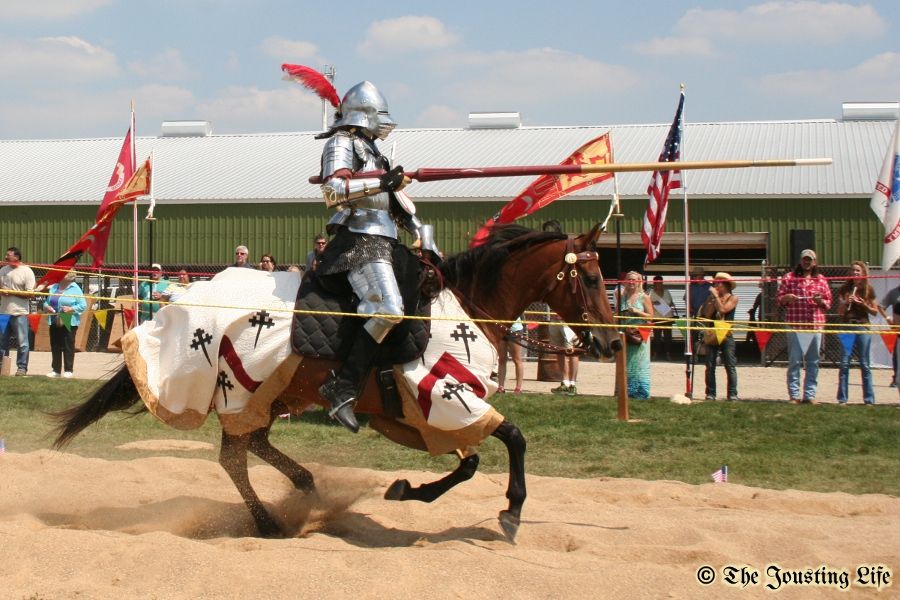
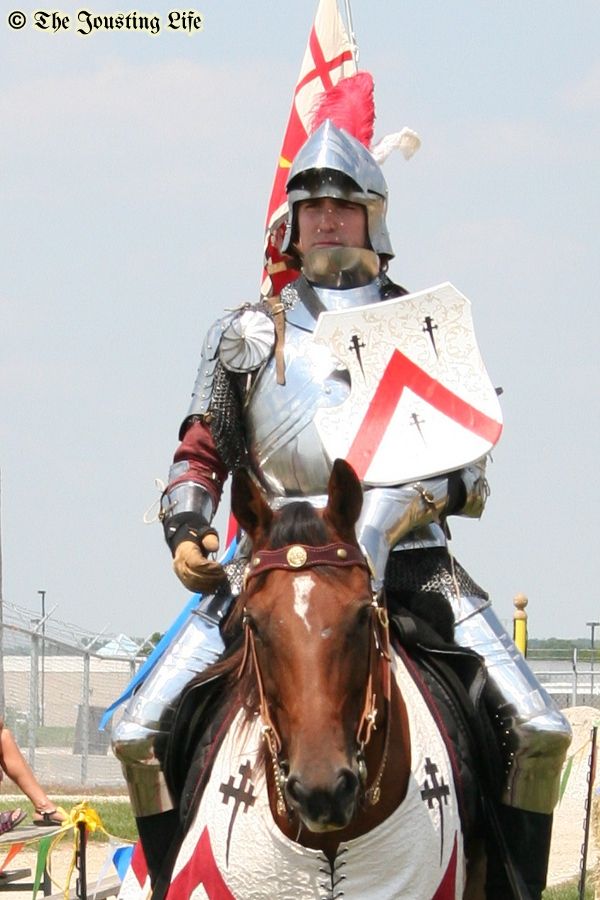
Jeffrey Basham's caparison reflects his coat of arms which is also displayed on his 'Ecranche'
(photos by The Jousting Life)
Chamfron: armour for protecting the horse's face. It can be made out of leather or metal. The word has been spelled in a variety of ways in different times and places. Two of the other popular spellings are 'shaffron' and 'chanfron'.
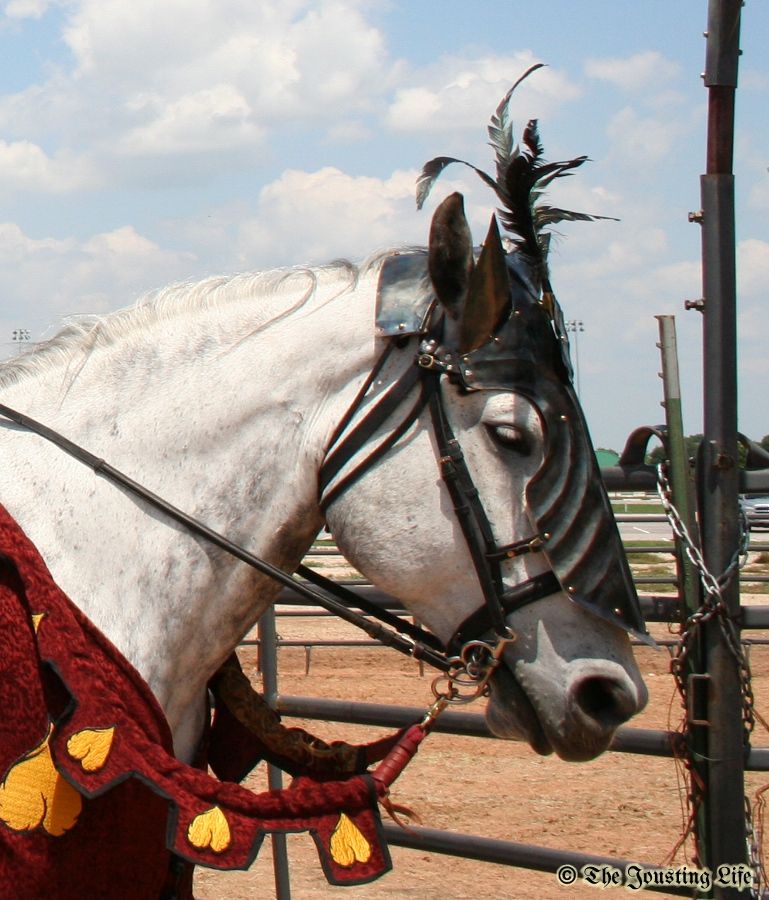
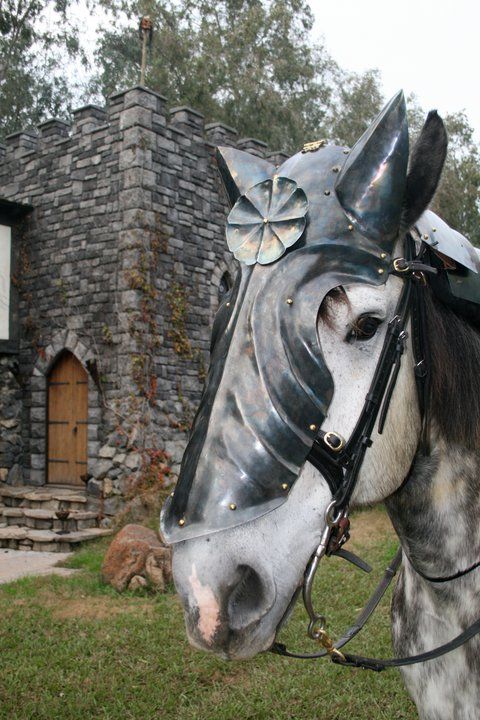
David Young's horse Boccaccio wearing his chamfron
(photos by The Jousting Life(left) and David Young(right))
Chivalric Martial Arts: a modern phrase that refers specifically to the kinds of 'Equestrian Martial Arts' used during the 12th through 16th centuries in Europe. A specific category within the broader category of 'Historical Mounted Martial Arts'.
Coronel: the shaped cap(frequently, but not exclusively, crown shaped) that is placed on the very tip of the lance. Coronels can come in a variety of shapes and materials.
Counter Tilt: see 'Tilt and Counter Tilt'
Court of Honour: a group of knowledgeable people who are in charge of judging the chivalry and horsemanship of all participants in the joust. In some tournaments, they have the ability to give extra points to those competitors who show higher levels of equestrian ability and/or chivalry. There may or may not be a 'Lady/Lord of Honour' who acts as the leader of the 'Court of Honour'. See also 'Ladies Court'
Crest: a decorative item placed on the top of a jouster's 'Helm'. It usually reflects the jouster's 'Heraldry' in some way. It can be a few feathers in the jouster's colors, an elaborate sculptural piece that depicts some aspect of the jouster's coat of arms or anything in between.

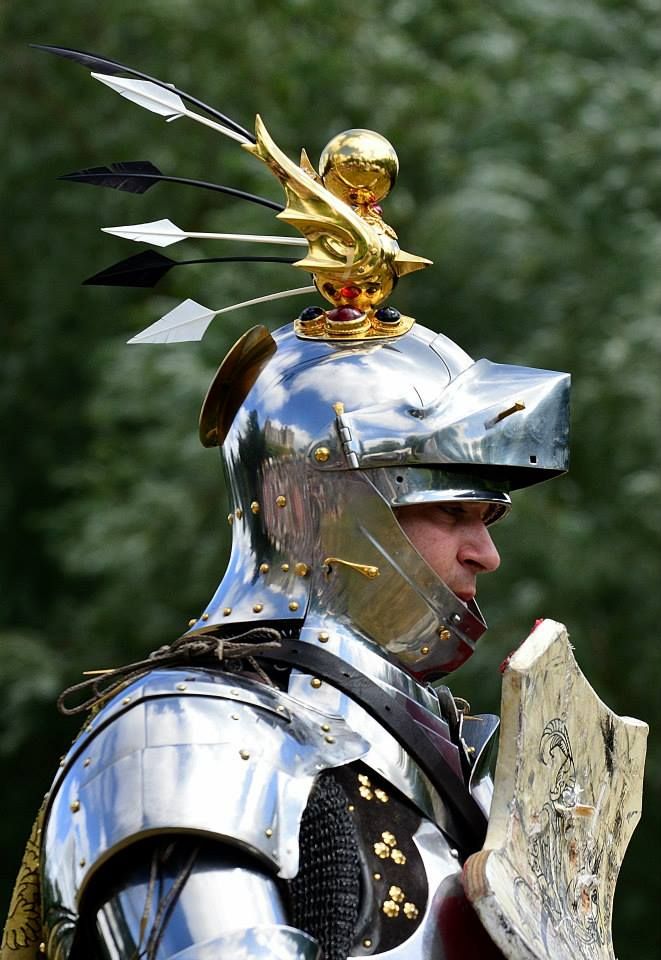
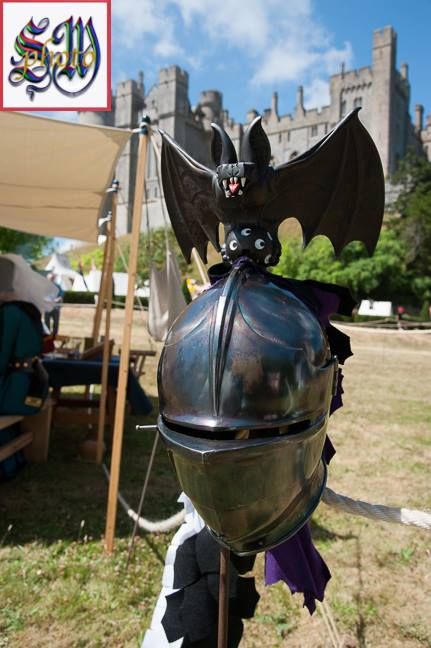
Jousting helms with a variety of crests(left), Stacy Evans' crest(middle), Steve Gagnon's crest(right)
(photos by Ulrike Otto(left), Richard Pearn(middle), Stephen Moss(right))
Crest Melee: a type of 'Mounted Melee', and specifically a type of 'Elimination Melee', where competitors attempt to strike off or destroy in some way any opposing competitor's 'Crest'. The last person or team with an intact crest wins.(crest melee video)
Crinet: armour for protecting the horse's neck. Usually made of articulated plates or a combination of plate and mail. Though it can also be made of leather. See also 'Articulation'
Ecranche: a small wooden jousting shield which is usually strapped onto a jouster's left shoulder, though sometimes it is bolted in place. Ecranches were a common jousting target used from the late 14th century to the early 16th century. Modern ecranches are usually painted with the jouster's 'Heraldry'.
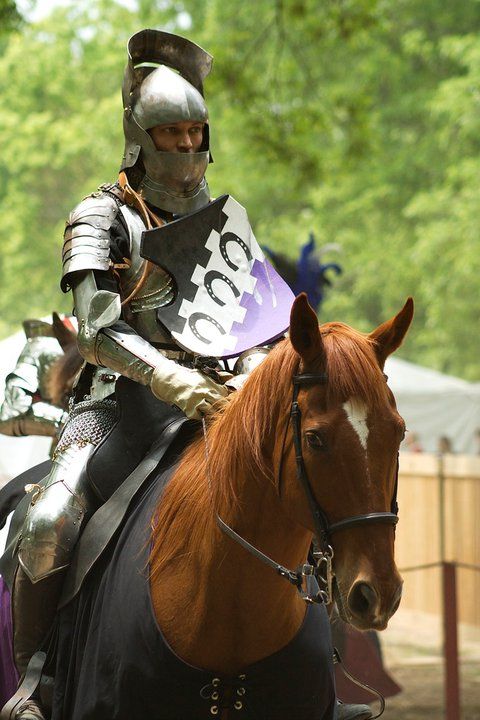
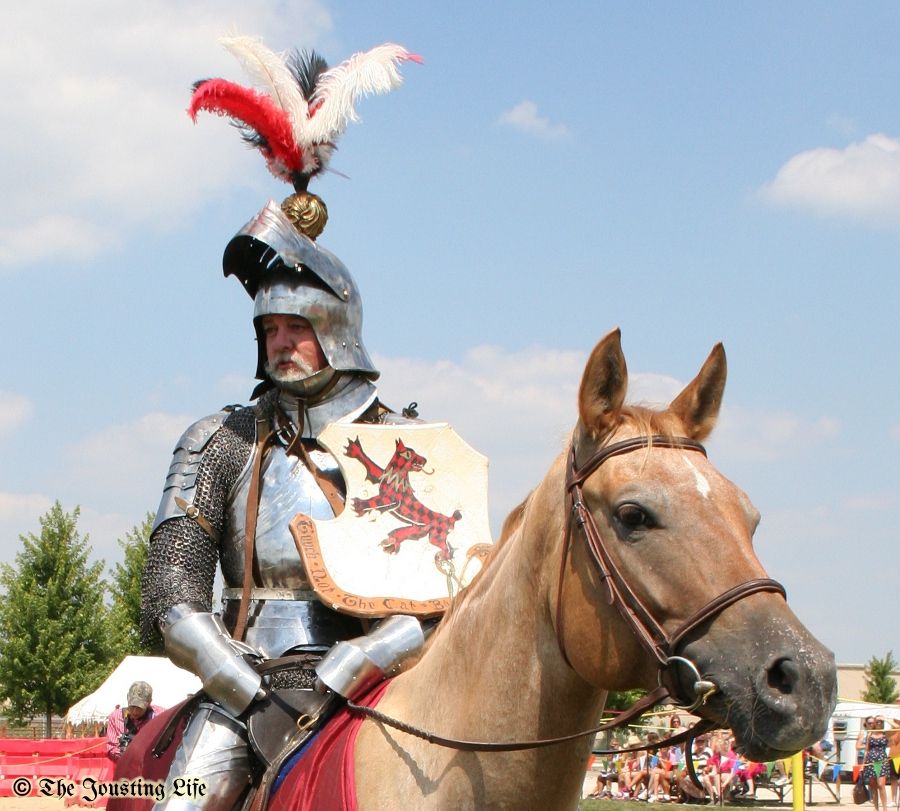
Ryan Saathoff(left) and Scott Wilson(right) wearing their ecranches
(photos by Jay Baum(left) and The Jousting Life(right))
Elimination Melee: a type of 'Mounted Melee' where competitors are eliminated throughout the competition based on a predetermined set of rules. The rules can be based on how many blows a competitor has received, how well a competitor defends his 'Crest' or various other objective standards. Or the rules can simply allow the competitor to withdraw when they feel they cannot or should not fight anymore. The competitor or team who has not been eliminated after every other competitor or team has been eliminated is the winner.(elimination melee video)
Equestrian Martial Arts: a general term that encompasses a broad variety of equestrian combat-based sports, including the variety of skills used in contemporary jousting tournaments (jousting, mounted melee, mounted archery, mounted skill at arms, mounted grappling, etc...)
Failure to Present: In jousting, unlike most other combat-based sports, there is NO defense. A jouster cannot block or dodge the opponent's lance during a pass. Instead the jouster must present themselves and their shield(ecranche, grand guard or heater) directly towards their opponent. If a jouster does not present themselves and their shield directly towards their opponent, it is called Failure to Present, and the jouster may receive a warning(for a first offense), be penalized in some way or even be disqualified from the competition altogether.
Ferrule: the metal tube used to connect the replaceable tip of a 'Frangible Lance' to the base of the lance.
Ferrule Strike: a lance hit so powerful that the entire replaceable tip of a 'Frangible Lance' is broken away, and the 'Ferrule' itself strikes solidly against the target.
Frangible Lance: In general use, the word frangible simply means breakable. However when used in reference to lances, it means a lance that has a replaceable tip that is designed to break upon sufficient impact and a base that is designed NOT to break so that it can be re-used. The base of a frangible lance can be straight and plain, or, since it is designed to be re-used, it can be more elaborately shaped and decorated. See also 'Lance'

The elaborately shaped bases of the frangible lances used at Lysts on the Lake 2011
(photo by Melanie Yenawine)
Games: see 'Mounted Skill at Arms'
Garniture: a more accurate term for a complete set of armour, one which includes additional pieces that can be added on or switched out when the armour is used for different purposes, such as ground combat, mounted combat or the joust.
Gauntlets: hand armour
Grand Guard or Gridded Grand Guard: a small metal jousting shield that is bolted onto the jouster's left shoulder. It may be smooth or have a series of raised grids. Grand guards were a common style of jousting target used in the mid to late 16th century.

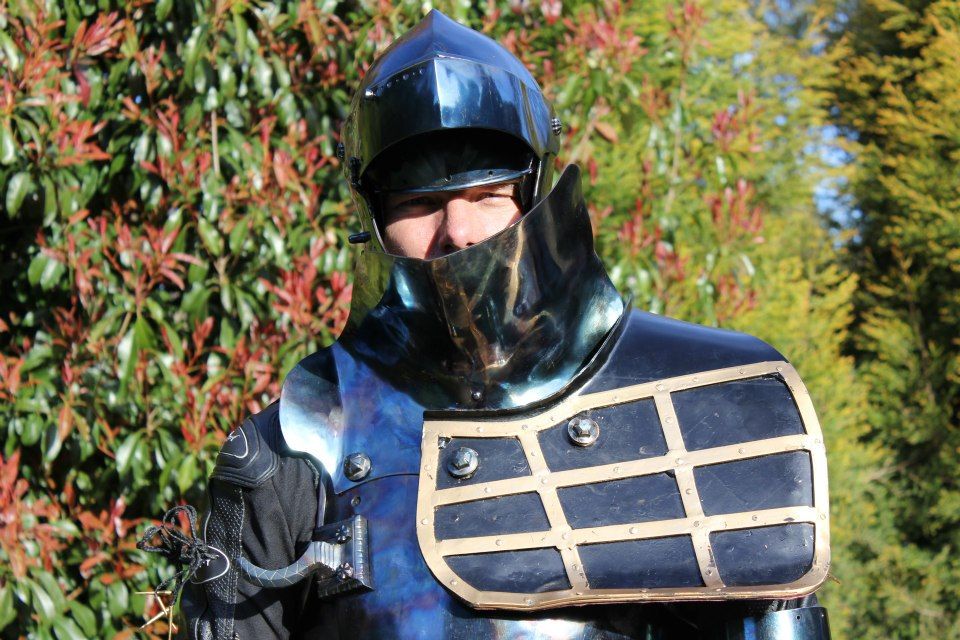
Left: Gridded Grand Guard from the Wallace Collection in London(photo from Steve Hemphill)
Right: Rod Walker's Gridded Grand Guard(photo from Rod Walker)
Grapper: see 'Arret and Grapper'
Groom: the member of the ground crew responsible for the care of the jouster's horse during the tournament.
Ground Crew: the absolutely essential personnel who organize and run the jousting tournament, set up and take down the 'Tilt' and other equipment, assist the jousters during the tournament, remove broken lance pieces from the 'Tilt Yard', and who generally make sure that everything that needs to be done actually gets done. See also 'Knight Marshal', 'Lady of Honour', 'Lance Handler', 'Lance Prepper', 'Runner', 'Scoring Judges' and 'Squires'.
Harness: When used in reference to armour, it is simply a more historically accurate term for a complete set of armour
Heater: a fairly large metal shield that is held in the left hand or strapped to the left arm during certain styles of jousting.
Helm: a piece of armour designed specifically to protect the head. There are many different styles of helms that can be worn for different types of combat.
Heraldry: the colors and symbols used to identify jousters. A contemporary jouster's 'Ecranche' is frequently painted with their heraldry.
Historical Equestrian Sports: A phrase used to refer to a variety of equestrian activities practiced in the present time, but designed to reproduce combat, hunting or sporting skills performed on horseback during various periods of history.
Historical Mounted Martial Arts: A phrase used to refer to a variety of 'Equestrian Martial Arts' practiced in the present time, but designed to reproduce combat skills performed on horseback during various periods of history. The word "mounted" is used instead of "equestrian" so that when abbreviated, HMMA is not confused with the abbreviation for 'Historical European Martial Arts' (HEMA).
Historical Solid Lance: a lance made from a solid piece of wood grown in (or sometimes worked into) a shape that tapers from a smaller tip to a broader base. Historical Solids are frequently made from young trees(which naturally taper from top to bottom), cut down, stripped of their branches and stored until they have dried out enough to be used as lances. See also 'Lance'
Horse Master: the person in charge over all of the grooms as well being ultimately responsible for the care and well-being of all the horses involved in the tournament.
International Jouster: a jouster who has competed in multiple countries.
Joust at Large: a joust done without a tilt. See also 'tilt and counter tilt'.
Jouster: a person who participates in the equestrian sport of jousting. Usually a jouster will be assisted during a tournament by one or more members of the ground crew, such as a valet and/or a groom.
Jousting Shield: any of several different kinds of shields used for jousting in various times and places. See 'Ecranche', 'Grand Guard' and 'Heater'.
Jousting Stick: see 'Lance'
King or Queen of Arms: see 'Knight Marshal'
Knight Marshal: the main referee for the jousting tournament. Also called 'King/Queen of Arms' or 'Marshal of the Field'.
Ladies Court: a type of 'Court of Honour' made up of knowledgeable people, usually female, who are in charge of judging the chivalry and horsemanship of all participants in the joust. In some tournaments, they have the ability to give extra points to those competitors who show higher levels of equestrian ability and/or chivalry. There may or may not be a 'Lady of Honour' who acts as the leader of the Ladies Court. See also 'Court of Honour'.
Lady/Lord of Honour: the person in charge of judging the chivalry and horsemanship of all participants. She makes sure that everyone behaves with good sportsmanship and handles their horses with both competence and kindness. Her duties and amount of authority may vary from tournament to tournament, and some tournaments do not have a Lady/Lord of Honour. If there is a 'Court of Honour' or a 'Ladies Court', then she is the leader of the court.
Lames: small pieces of armour, usually narrow rectangular strips, that are connected together using sliding rivets or internal leather straps to create articulated pieces of armour. See also 'Articulation'
Lance: the long weapon used in jousting. Contemporary lances are usually about 11' (apx 3.3m) long. They can vary in a couple of significant ways. They can be frangible(having a replaceable tip that is designed to break upon sufficient impact and a base that is designed NOT to break so that it can be re-used) or solid(one piece construction where the entire wooden part of the lance is discarded after it breaks); and they can be straight(the same diameter from tip to base) or shaped(having a narrower diameter at the tip and a wider diameter at the base). Thus there are four basic designs for lances:
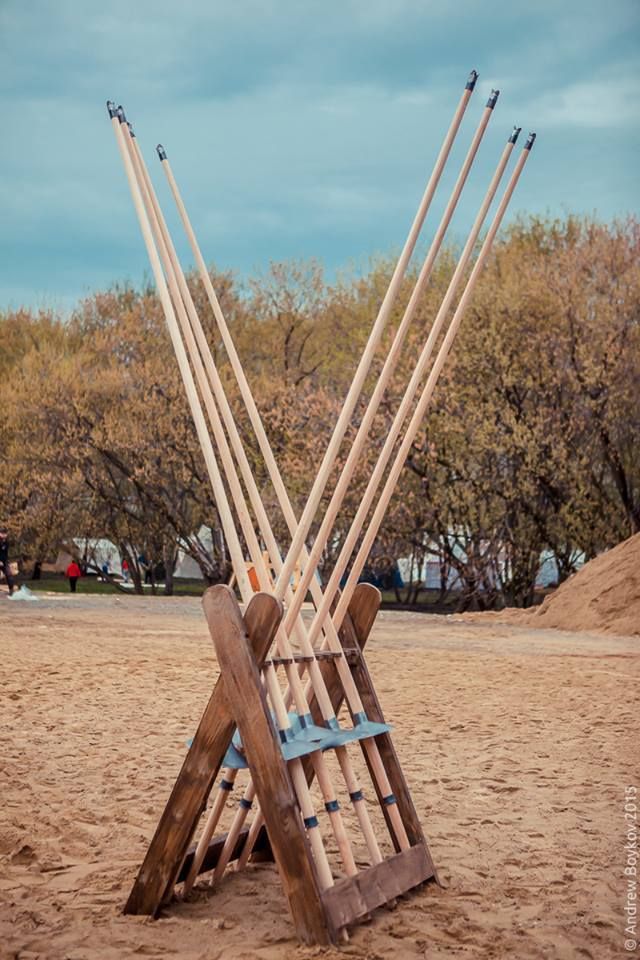
Shaped Solid Lances with coronels, vamplates and grappers used at the
Russian Tournament of St. George 2015 (photo by Andrew Boykov)
Lance Handlers: members of the Ground Crew who hand the lance up to the jouster at the beginning of a jousting pass and receive the lance from the jouster at the end of the jousting pass. See also 'Ground Crew'.
Lance Preppers: members of the Ground Crew who prepare the lances to be used during a jousting pass. When Frangible Lances are used, this may involve removing broken tips from the re-usable base and replacing them with new tips. If Solid Lances are used, this may involve removing the re-usable parts(Coronels, Vamplates, Grappers, etc...) from the broken lances and adding them to new lances. See also 'Ground Crew'.
Levée: the slow graceful lowering of the lance, perfectly timed to meet your opponent's shield as you pass the center of the tilt. After engaging your opponent, with your lance broken or not, you proceed to just as elegantly raise it so that it is in an upright position when you reach the end of the tilt.
Line Judges: referees that help the 'Knight Marshal' with scoring and making sure that all the safety regulations are followed. Also called 'Sergeant Marshals'. See also 'Ground Crew'.
List Field or Lists: the arena or designated area where the jousting tournament takes place. The List Field includes not just the 'Tilt Yard', but also the areas for 'Mounted Melee', 'Mounted Skill at Arms' and/or any other activity included in the tournament.
Mail or Maille: a type of armour created by linking small metal rings together into a flexible, but protective mesh
Marshals: the referees for the tournament, see also 'Knight Marshal' and 'Ground Crew'
Match: a series of 'Passes' between the same two jousters done consecutively with minimal or no break between passes. A series of 'Matches' done one after the other with minimal time between them is a 'Session'.
Mercy Pass: A jouster experiencing significant difficulty after the jousting 'Pass' has started, but before the two jousters have met, may deliberately swing their lance far off target as an indication that they are asking for mercy (i.e. not to be hit). If the opposing jouster sees that the first jouster has asked for a 'Mercy Pass', they are expected to pull their lance off target as well. HOWEVER, due to the extremely limited visibility through a jousting helm, the opposing jouster cannot always see that the first jouster has asked for a mercy pass. Therefore it is understood that asking for a mercy pass does not always mean that you will receive it.
Mounted Duel: any of a variety of forms of mounted combat between two (and only two) competitors performed as a sporting competition. A mounted duel is frequently done using swords, but can also be done using other weapons or no weapons at all(mounted grappling).
Mounted Melee: any of a variety of forms of mounted combat involving three or more competitors performed as a sporting competition rather than an actual battle. There are a number of different styles of mounted melee. Mounted melees can also involve team or individual competition(every participant vs every other participant). Some of the more common forms of mounted melee are 'Timed melees', 'Elimination Melees' and 'Crest Melees'. (Click on names to see videos)
Mounted Skill at Arms(MSA): sometimes referred to as 'games'. Any of a number of different styles of competition involving the skilled use of weapons while mounted. The competition may be done individually or in teams of two or more. The skills may be combat-based and/or hunt-based and may include tilting at rings, cut and thrust, thrown spear, mounted archery, tilting against the quintain, pig-sticking, tent pegging and many other tests of skill, including basic equitation(your horse, and the ability to ride him well, may be the most important skill you can have in any type of mounted weapons use). There are two major types of MSA competition:
Mounted Valet: a member of the ground crew that remains mounted on a horse in order to be better able to assist in various ways, including quickly carrying broken lances to the Knight Marshall for him/her to evaluate and running lances from one end of the tiltyard to the other as needed. Their mounts can also be very useful in keeping the jousting horses company between passes and in helping to guide the jousting horses into the tilt.
National Jouster: a jouster who has competed in multiple states/provinces/regions/etc... within their home country. See also 'International Jouster'
Pass: the single instance of two jousters cantering the length of the tilt while carrying lances and attempting to strike one another. A consecutive series of passes between the same two jousters makes a 'Match'.
Pauldrons: shoulder armour
Pommel: the front part of a saddle
Quintain: A 'Quintain' is an apparatus with a small shield or target set at approximately the height to represent an opposing jouster's shield. The target is on one end of a spinning plank that has a weighted bag on the other end. The quintain is used to practice aiming the tip of the lance at a small target that provides a small amount of resistance. See also 'Shock Quintain'.
Runners: members of the ground crew who collect the broken pieces of lance between each jousting pass. They also gather any re-usable equipment(such as 'Coronels') and return them to the Lance Preppers. See also 'Ground Crew'.
Sabatons: foot armour

A close up of the sabatons that Arne Koets wore at the Blacktown Tournament 2013
(photo by Garry Davenport)
Scoring Judges: referees that help the 'Knight Marshal' with scoring and making sure that all the safety rules are followed. Also called 'Sergeant Marshals'. See also 'Ground Crew'.
Session: A series of jousting 'Matches', 'Mounted Melees' and/or 'Mounted Skill at Arms' runs done one after the other with minimal time between them. There are usually several 'Sessions' of competition, sometimes over two or more days, within a tournament.
Sergeant Marshals: referees that help the 'Knight Marshal' with scoring and making sure that all the safety rules are followed. Also called 'Line Judges' or 'Scoring Judges'. See also 'Ground Crew'.
Shaffron: see 'Chamfron'
Shock Quintain: A 'Shock Quintain' is a shield or target that is heavily weighted or attached to the ground with springs in such a way that it is very difficult to knock over. Shock quintains can vary a great deal in design. They are used to train both rider and horse to withstand the shock of hitting the opposing rider with their lance. See also 'Quintain'.
Soft kit: the historical clothing that a jouster wears when not wearing armour.
Squire: See 'Valet'
Targe: a word that commonly refers to a round hand held shield used in ground combat, particularly by the Scottish Highlanders. It can also be used to refer to the shoulder shield that is targeted in jousting. See also 'Ecranche' and 'Grand Guard'.
Tenan and Venan: The 'Tenan' is the jouster considered to be defending the field in a series of jousting passes. The 'Venan' is the jouster considered to be challenging the defender of the field in a series of jousting passes. Not all tournaments are designed to incorporate the concept of tenans and venans.
Tilting: the original term for what is now generally referred to as jousting
Tilt and Counter Tilt: The 'Tilt' is the barrier between the two opposing jousters. It can be a solid fence, a wooden rail, a length of fabric or even a simple rope. The 'Counter Tilt' is another barrier, usually shorter in height than the Tilt, that defines the outside edge of the lane down which the jousters will canter. It can be a wooden rail, a length of fabric or a simple rope. Not every 'Tilt Yard' includes a 'Counter Tilt'.
Tilt Yard: the area where the 'Tilt' with or without a 'Counter Tilt' is set up
Timed Melee: a type of 'Mounted Melee' where competitors continue combat for a specified length of time. When the time is up, a winner or winning team is declared based on some predetermined standard. (timed melee video)
Valet: the member of the ground crew responsible for the care of the jouster and his/her personal equipment(armour, shield, weapons, etc...) during the tournament. The valet will help carry the jouster's helm, shield and other personal equipment onto and off of the list field, and will help the jouster put on, take off or adjust his/her armour. The valet may or may not also be responsible for handing the jouster the lance before a jousting pass (see also Lance Handler). They may also help out with other ground crewing work. The valet basically fulfills the function of the historical squire to the historical knight, but because the term 'squire'(short for esquire) can actually refer to a specific rank or title(as the term 'knight' more obviously does), the modern term 'valet' is used instead.
Vamplate: the flared round metal “shield” that sits on the base of the lance just in front of the jouster's hand. Some lances include vamplates and some do not.
Venan: See 'Tenan and Venan'
Yard Master: the person in charge over all of the members of the ground crew
Last update: July 13, 2016
This dictionary is an attempt to create a standardized vocabulary for use when discussing contemporary competitive jousting. It is based not only on historical sources(which can vary greatly depending on time and place), but also on modern websites that deal with jousting, and discussions held between jousters/crew on social networking sites and at tournaments.
If you have suggestions for words/phrases to add to the dictionary, changes to existing definitions and/or other ways to improve this page, please email The Jousting Life. If you have a question about a word/phrase(either on this list or not), feel free to email TJL and ask about it.
Click on the pictures to enlarge.
Arçon: a traditional French word for the front part of a saddle, in English it's generally called the 'Pommel'.
Armour: the protective clothing worn by the jouster and sometimes the horse during jousting. It is usually metal, but occasionally leather or other materials are used depending on the type of jousting being done.
Arret and Grapper: The 'Arret' is a sort of hook attached to the breastplate of jousting armour for the base of the lance to rest upon. (Some breastplates include an arret and some do not.) The 'Grapper' is a sort of tight ring attached to the base of the lance just in front of where the lance rests upon the arret. The arret and grapper work together to hold the lance in place and prevent it from sliding backward in the jouster's grip during impact. They may or may not also increase the force of the hit.
Articulation: in plate armour, it refers to the use of several smaller pieces of armour, such as 'Lames', connected to one another using sliding rivets or internal leather straps in order to achieve flexibility
Barricade: In jousting, when a jouster's lance tip has been swung too far to the left of the oncoming opponent(from the point of view of the oncoming opponent, it is too far to the right), it can form a 'barricade' across the opponent's body, and the lance can break because of the lever action against the lance as the opponent rides through this 'barricade'. Although the lance has broken, it is not considered a legal, or point-scoring, break in most tournaments for two reasons:
- Firstly, because the force of the oncoming opponent against the side of the lance frequently causes the jouster to lose control of the lance, and any loss of control of the lance is dangerous.
- Secondly, because the lance was NOT broken by accurately striking the TIP of the lance against the opponent's shield or upper body, but rather by hitting the opponent with the side of the lance.
Cantle: the rear part of a saddle
Caparison: the fancy cloth or strapping(Strap Caparison) that covers the horse during tournaments. It usually displays the jouster's colors and sometimes their coat of arms. It is not designed to provide protection; it simply helps to identify the jousters and adds to the pageantry of the joust.


Jeffrey Basham's caparison reflects his coat of arms which is also displayed on his 'Ecranche'
(photos by The Jousting Life)
Chamfron: armour for protecting the horse's face. It can be made out of leather or metal. The word has been spelled in a variety of ways in different times and places. Two of the other popular spellings are 'shaffron' and 'chanfron'.


David Young's horse Boccaccio wearing his chamfron
(photos by The Jousting Life(left) and David Young(right))
Chivalric Martial Arts: a modern phrase that refers specifically to the kinds of 'Equestrian Martial Arts' used during the 12th through 16th centuries in Europe. A specific category within the broader category of 'Historical Mounted Martial Arts'.
Coronel: the shaped cap(frequently, but not exclusively, crown shaped) that is placed on the very tip of the lance. Coronels can come in a variety of shapes and materials.
Counter Tilt: see 'Tilt and Counter Tilt'
Court of Honour: a group of knowledgeable people who are in charge of judging the chivalry and horsemanship of all participants in the joust. In some tournaments, they have the ability to give extra points to those competitors who show higher levels of equestrian ability and/or chivalry. There may or may not be a 'Lady/Lord of Honour' who acts as the leader of the 'Court of Honour'. See also 'Ladies Court'
Crest: a decorative item placed on the top of a jouster's 'Helm'. It usually reflects the jouster's 'Heraldry' in some way. It can be a few feathers in the jouster's colors, an elaborate sculptural piece that depicts some aspect of the jouster's coat of arms or anything in between.



Jousting helms with a variety of crests(left), Stacy Evans' crest(middle), Steve Gagnon's crest(right)
(photos by Ulrike Otto(left), Richard Pearn(middle), Stephen Moss(right))
Crest Melee: a type of 'Mounted Melee', and specifically a type of 'Elimination Melee', where competitors attempt to strike off or destroy in some way any opposing competitor's 'Crest'. The last person or team with an intact crest wins.(crest melee video)
Crinet: armour for protecting the horse's neck. Usually made of articulated plates or a combination of plate and mail. Though it can also be made of leather. See also 'Articulation'
Ecranche: a small wooden jousting shield which is usually strapped onto a jouster's left shoulder, though sometimes it is bolted in place. Ecranches were a common jousting target used from the late 14th century to the early 16th century. Modern ecranches are usually painted with the jouster's 'Heraldry'.


Ryan Saathoff(left) and Scott Wilson(right) wearing their ecranches
(photos by Jay Baum(left) and The Jousting Life(right))
Elimination Melee: a type of 'Mounted Melee' where competitors are eliminated throughout the competition based on a predetermined set of rules. The rules can be based on how many blows a competitor has received, how well a competitor defends his 'Crest' or various other objective standards. Or the rules can simply allow the competitor to withdraw when they feel they cannot or should not fight anymore. The competitor or team who has not been eliminated after every other competitor or team has been eliminated is the winner.(elimination melee video)
Equestrian Martial Arts: a general term that encompasses a broad variety of equestrian combat-based sports, including the variety of skills used in contemporary jousting tournaments (jousting, mounted melee, mounted archery, mounted skill at arms, mounted grappling, etc...)
Failure to Present: In jousting, unlike most other combat-based sports, there is NO defense. A jouster cannot block or dodge the opponent's lance during a pass. Instead the jouster must present themselves and their shield(ecranche, grand guard or heater) directly towards their opponent. If a jouster does not present themselves and their shield directly towards their opponent, it is called Failure to Present, and the jouster may receive a warning(for a first offense), be penalized in some way or even be disqualified from the competition altogether.
Ferrule: the metal tube used to connect the replaceable tip of a 'Frangible Lance' to the base of the lance.
Ferrule Strike: a lance hit so powerful that the entire replaceable tip of a 'Frangible Lance' is broken away, and the 'Ferrule' itself strikes solidly against the target.
Frangible Lance: In general use, the word frangible simply means breakable. However when used in reference to lances, it means a lance that has a replaceable tip that is designed to break upon sufficient impact and a base that is designed NOT to break so that it can be re-used. The base of a frangible lance can be straight and plain, or, since it is designed to be re-used, it can be more elaborately shaped and decorated. See also 'Lance'

The elaborately shaped bases of the frangible lances used at Lysts on the Lake 2011
(photo by Melanie Yenawine)
Games: see 'Mounted Skill at Arms'
Garniture: a more accurate term for a complete set of armour, one which includes additional pieces that can be added on or switched out when the armour is used for different purposes, such as ground combat, mounted combat or the joust.
Gauntlets: hand armour
Grand Guard or Gridded Grand Guard: a small metal jousting shield that is bolted onto the jouster's left shoulder. It may be smooth or have a series of raised grids. Grand guards were a common style of jousting target used in the mid to late 16th century.


Left: Gridded Grand Guard from the Wallace Collection in London(photo from Steve Hemphill)
Right: Rod Walker's Gridded Grand Guard(photo from Rod Walker)
Grapper: see 'Arret and Grapper'
Groom: the member of the ground crew responsible for the care of the jouster's horse during the tournament.
Ground Crew: the absolutely essential personnel who organize and run the jousting tournament, set up and take down the 'Tilt' and other equipment, assist the jousters during the tournament, remove broken lance pieces from the 'Tilt Yard', and who generally make sure that everything that needs to be done actually gets done. See also 'Knight Marshal', 'Lady of Honour', 'Lance Handler', 'Lance Prepper', 'Runner', 'Scoring Judges' and 'Squires'.
Harness: When used in reference to armour, it is simply a more historically accurate term for a complete set of armour
Heater: a fairly large metal shield that is held in the left hand or strapped to the left arm during certain styles of jousting.
Helm: a piece of armour designed specifically to protect the head. There are many different styles of helms that can be worn for different types of combat.
Heraldry: the colors and symbols used to identify jousters. A contemporary jouster's 'Ecranche' is frequently painted with their heraldry.
Historical Equestrian Sports: A phrase used to refer to a variety of equestrian activities practiced in the present time, but designed to reproduce combat, hunting or sporting skills performed on horseback during various periods of history.
Historical Mounted Martial Arts: A phrase used to refer to a variety of 'Equestrian Martial Arts' practiced in the present time, but designed to reproduce combat skills performed on horseback during various periods of history. The word "mounted" is used instead of "equestrian" so that when abbreviated, HMMA is not confused with the abbreviation for 'Historical European Martial Arts' (HEMA).
Historical Solid Lance: a lance made from a solid piece of wood grown in (or sometimes worked into) a shape that tapers from a smaller tip to a broader base. Historical Solids are frequently made from young trees(which naturally taper from top to bottom), cut down, stripped of their branches and stored until they have dried out enough to be used as lances. See also 'Lance'
Horse Master: the person in charge over all of the grooms as well being ultimately responsible for the care and well-being of all the horses involved in the tournament.
International Jouster: a jouster who has competed in multiple countries.
Joust at Large: a joust done without a tilt. See also 'tilt and counter tilt'.
Jouster: a person who participates in the equestrian sport of jousting. Usually a jouster will be assisted during a tournament by one or more members of the ground crew, such as a valet and/or a groom.
Jousting Shield: any of several different kinds of shields used for jousting in various times and places. See 'Ecranche', 'Grand Guard' and 'Heater'.
Jousting Stick: see 'Lance'
King or Queen of Arms: see 'Knight Marshal'
Knight Marshal: the main referee for the jousting tournament. Also called 'King/Queen of Arms' or 'Marshal of the Field'.
Ladies Court: a type of 'Court of Honour' made up of knowledgeable people, usually female, who are in charge of judging the chivalry and horsemanship of all participants in the joust. In some tournaments, they have the ability to give extra points to those competitors who show higher levels of equestrian ability and/or chivalry. There may or may not be a 'Lady of Honour' who acts as the leader of the Ladies Court. See also 'Court of Honour'.
Lady/Lord of Honour: the person in charge of judging the chivalry and horsemanship of all participants. She makes sure that everyone behaves with good sportsmanship and handles their horses with both competence and kindness. Her duties and amount of authority may vary from tournament to tournament, and some tournaments do not have a Lady/Lord of Honour. If there is a 'Court of Honour' or a 'Ladies Court', then she is the leader of the court.
Lames: small pieces of armour, usually narrow rectangular strips, that are connected together using sliding rivets or internal leather straps to create articulated pieces of armour. See also 'Articulation'
Lance: the long weapon used in jousting. Contemporary lances are usually about 11' (apx 3.3m) long. They can vary in a couple of significant ways. They can be frangible(having a replaceable tip that is designed to break upon sufficient impact and a base that is designed NOT to break so that it can be re-used) or solid(one piece construction where the entire wooden part of the lance is discarded after it breaks); and they can be straight(the same diameter from tip to base) or shaped(having a narrower diameter at the tip and a wider diameter at the base). Thus there are four basic designs for lances:
- Straight Frangible
- Shaped Frangible
- Straight Solid
- Shaped Solid (aka 'Historical Solid')

Shaped Solid Lances with coronels, vamplates and grappers used at the
Russian Tournament of St. George 2015 (photo by Andrew Boykov)
Lance Handlers: members of the Ground Crew who hand the lance up to the jouster at the beginning of a jousting pass and receive the lance from the jouster at the end of the jousting pass. See also 'Ground Crew'.
Lance Preppers: members of the Ground Crew who prepare the lances to be used during a jousting pass. When Frangible Lances are used, this may involve removing broken tips from the re-usable base and replacing them with new tips. If Solid Lances are used, this may involve removing the re-usable parts(Coronels, Vamplates, Grappers, etc...) from the broken lances and adding them to new lances. See also 'Ground Crew'.
Levée: the slow graceful lowering of the lance, perfectly timed to meet your opponent's shield as you pass the center of the tilt. After engaging your opponent, with your lance broken or not, you proceed to just as elegantly raise it so that it is in an upright position when you reach the end of the tilt.
Line Judges: referees that help the 'Knight Marshal' with scoring and making sure that all the safety regulations are followed. Also called 'Sergeant Marshals'. See also 'Ground Crew'.
List Field or Lists: the arena or designated area where the jousting tournament takes place. The List Field includes not just the 'Tilt Yard', but also the areas for 'Mounted Melee', 'Mounted Skill at Arms' and/or any other activity included in the tournament.
Mail or Maille: a type of armour created by linking small metal rings together into a flexible, but protective mesh
Marshals: the referees for the tournament, see also 'Knight Marshal' and 'Ground Crew'
Match: a series of 'Passes' between the same two jousters done consecutively with minimal or no break between passes. A series of 'Matches' done one after the other with minimal time between them is a 'Session'.
Mercy Pass: A jouster experiencing significant difficulty after the jousting 'Pass' has started, but before the two jousters have met, may deliberately swing their lance far off target as an indication that they are asking for mercy (i.e. not to be hit). If the opposing jouster sees that the first jouster has asked for a 'Mercy Pass', they are expected to pull their lance off target as well. HOWEVER, due to the extremely limited visibility through a jousting helm, the opposing jouster cannot always see that the first jouster has asked for a mercy pass. Therefore it is understood that asking for a mercy pass does not always mean that you will receive it.
Mounted Duel: any of a variety of forms of mounted combat between two (and only two) competitors performed as a sporting competition. A mounted duel is frequently done using swords, but can also be done using other weapons or no weapons at all(mounted grappling).
Mounted Melee: any of a variety of forms of mounted combat involving three or more competitors performed as a sporting competition rather than an actual battle. There are a number of different styles of mounted melee. Mounted melees can also involve team or individual competition(every participant vs every other participant). Some of the more common forms of mounted melee are 'Timed melees', 'Elimination Melees' and 'Crest Melees'. (Click on names to see videos)
Mounted Skill at Arms(MSA): sometimes referred to as 'games'. Any of a number of different styles of competition involving the skilled use of weapons while mounted. The competition may be done individually or in teams of two or more. The skills may be combat-based and/or hunt-based and may include tilting at rings, cut and thrust, thrown spear, mounted archery, tilting against the quintain, pig-sticking, tent pegging and many other tests of skill, including basic equitation(your horse, and the ability to ride him well, may be the most important skill you can have in any type of mounted weapons use). There are two major types of MSA competition:
- MSA – Individual Skills(aka MSA games): a competition where each skill is run separately
- MSA – Combined Course(aka MSA Course): a competition where a number of different skills are combined in one run. (video of an MSA Course)
Mounted Valet: a member of the ground crew that remains mounted on a horse in order to be better able to assist in various ways, including quickly carrying broken lances to the Knight Marshall for him/her to evaluate and running lances from one end of the tiltyard to the other as needed. Their mounts can also be very useful in keeping the jousting horses company between passes and in helping to guide the jousting horses into the tilt.
National Jouster: a jouster who has competed in multiple states/provinces/regions/etc... within their home country. See also 'International Jouster'
Pass: the single instance of two jousters cantering the length of the tilt while carrying lances and attempting to strike one another. A consecutive series of passes between the same two jousters makes a 'Match'.
Pauldrons: shoulder armour
Pommel: the front part of a saddle
Quintain: A 'Quintain' is an apparatus with a small shield or target set at approximately the height to represent an opposing jouster's shield. The target is on one end of a spinning plank that has a weighted bag on the other end. The quintain is used to practice aiming the tip of the lance at a small target that provides a small amount of resistance. See also 'Shock Quintain'.
Runners: members of the ground crew who collect the broken pieces of lance between each jousting pass. They also gather any re-usable equipment(such as 'Coronels') and return them to the Lance Preppers. See also 'Ground Crew'.
Sabatons: foot armour

A close up of the sabatons that Arne Koets wore at the Blacktown Tournament 2013
(photo by Garry Davenport)
Scoring Judges: referees that help the 'Knight Marshal' with scoring and making sure that all the safety rules are followed. Also called 'Sergeant Marshals'. See also 'Ground Crew'.
Session: A series of jousting 'Matches', 'Mounted Melees' and/or 'Mounted Skill at Arms' runs done one after the other with minimal time between them. There are usually several 'Sessions' of competition, sometimes over two or more days, within a tournament.
Sergeant Marshals: referees that help the 'Knight Marshal' with scoring and making sure that all the safety rules are followed. Also called 'Line Judges' or 'Scoring Judges'. See also 'Ground Crew'.
Shaffron: see 'Chamfron'
Shock Quintain: A 'Shock Quintain' is a shield or target that is heavily weighted or attached to the ground with springs in such a way that it is very difficult to knock over. Shock quintains can vary a great deal in design. They are used to train both rider and horse to withstand the shock of hitting the opposing rider with their lance. See also 'Quintain'.
Soft kit: the historical clothing that a jouster wears when not wearing armour.
Squire: See 'Valet'
Targe: a word that commonly refers to a round hand held shield used in ground combat, particularly by the Scottish Highlanders. It can also be used to refer to the shoulder shield that is targeted in jousting. See also 'Ecranche' and 'Grand Guard'.
Tenan and Venan: The 'Tenan' is the jouster considered to be defending the field in a series of jousting passes. The 'Venan' is the jouster considered to be challenging the defender of the field in a series of jousting passes. Not all tournaments are designed to incorporate the concept of tenans and venans.
Tilting: the original term for what is now generally referred to as jousting
Tilt and Counter Tilt: The 'Tilt' is the barrier between the two opposing jousters. It can be a solid fence, a wooden rail, a length of fabric or even a simple rope. The 'Counter Tilt' is another barrier, usually shorter in height than the Tilt, that defines the outside edge of the lane down which the jousters will canter. It can be a wooden rail, a length of fabric or a simple rope. Not every 'Tilt Yard' includes a 'Counter Tilt'.
Tilt Yard: the area where the 'Tilt' with or without a 'Counter Tilt' is set up
Timed Melee: a type of 'Mounted Melee' where competitors continue combat for a specified length of time. When the time is up, a winner or winning team is declared based on some predetermined standard. (timed melee video)
Valet: the member of the ground crew responsible for the care of the jouster and his/her personal equipment(armour, shield, weapons, etc...) during the tournament. The valet will help carry the jouster's helm, shield and other personal equipment onto and off of the list field, and will help the jouster put on, take off or adjust his/her armour. The valet may or may not also be responsible for handing the jouster the lance before a jousting pass (see also Lance Handler). They may also help out with other ground crewing work. The valet basically fulfills the function of the historical squire to the historical knight, but because the term 'squire'(short for esquire) can actually refer to a specific rank or title(as the term 'knight' more obviously does), the modern term 'valet' is used instead.
Vamplate: the flared round metal “shield” that sits on the base of the lance just in front of the jouster's hand. Some lances include vamplates and some do not.
Venan: See 'Tenan and Venan'
Yard Master: the person in charge over all of the members of the ground crew

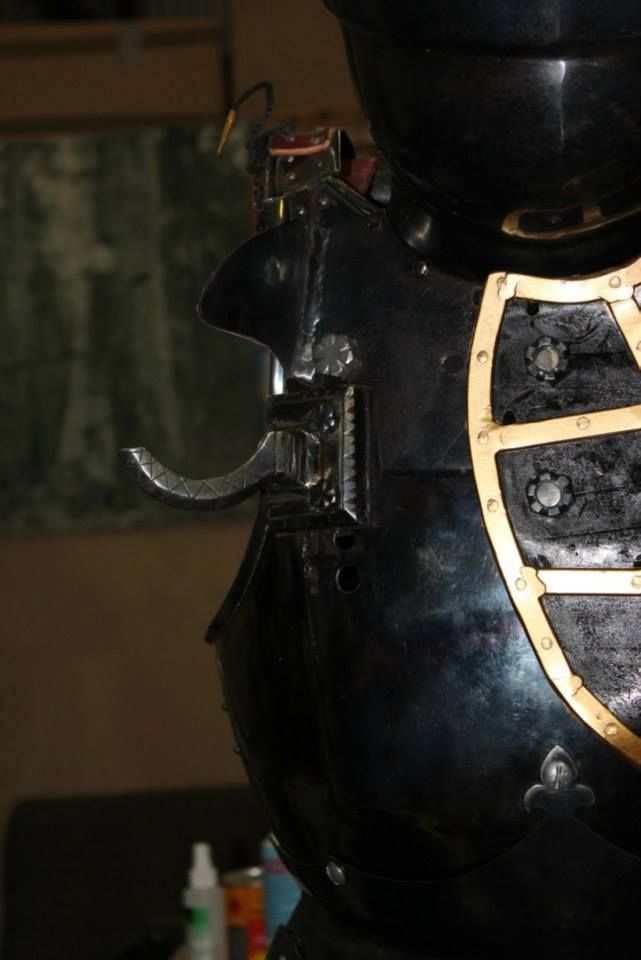

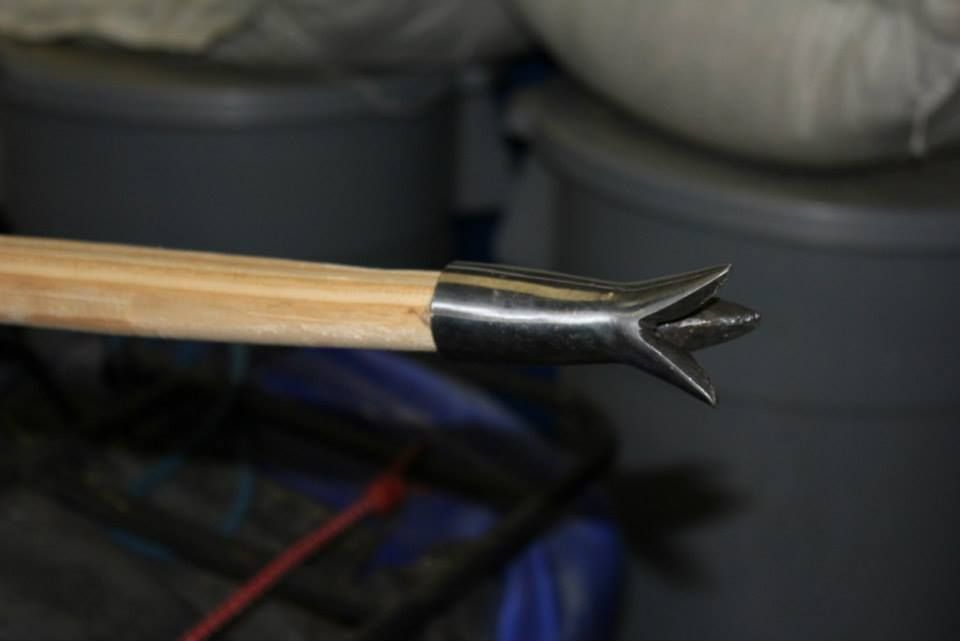
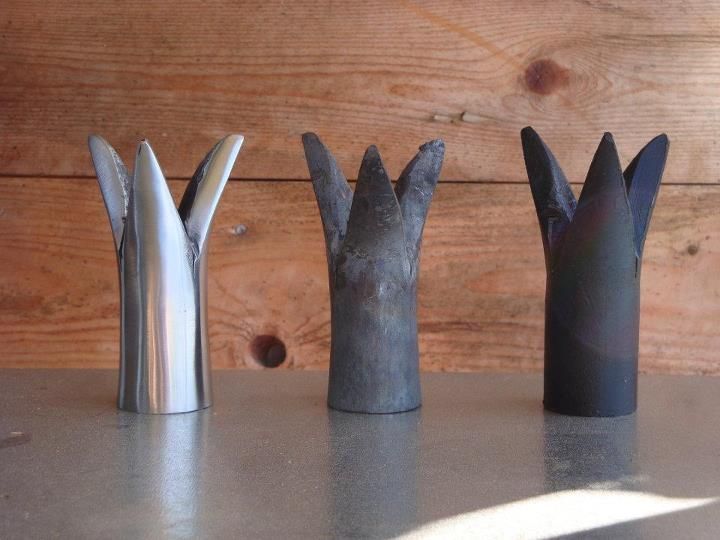

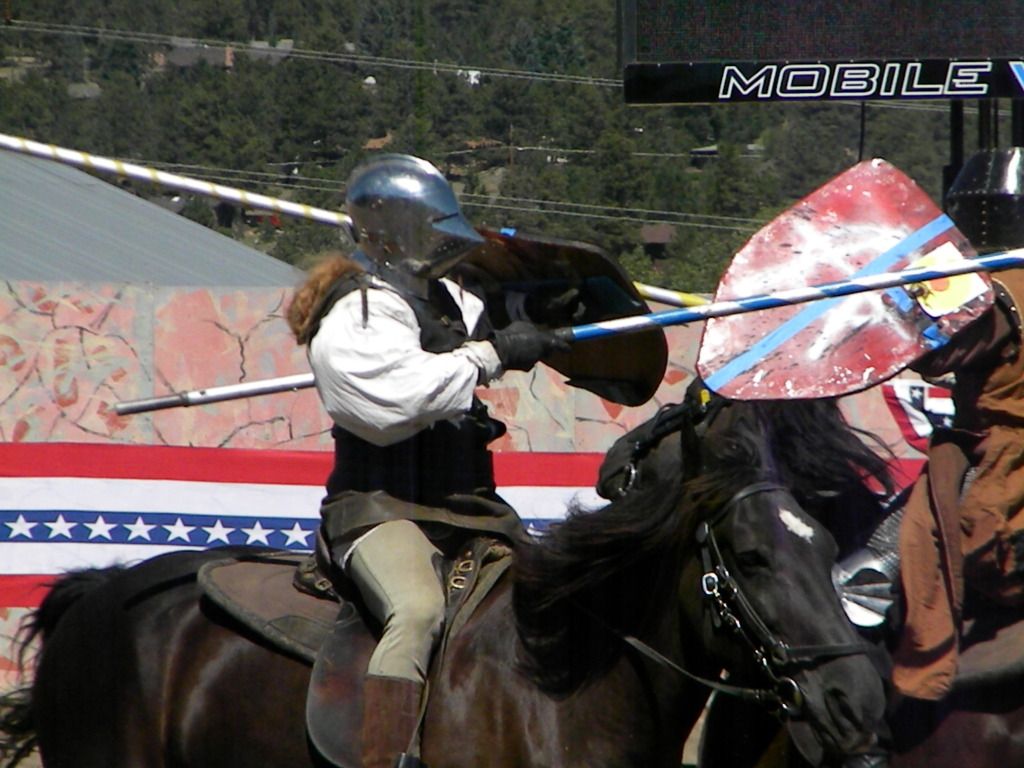
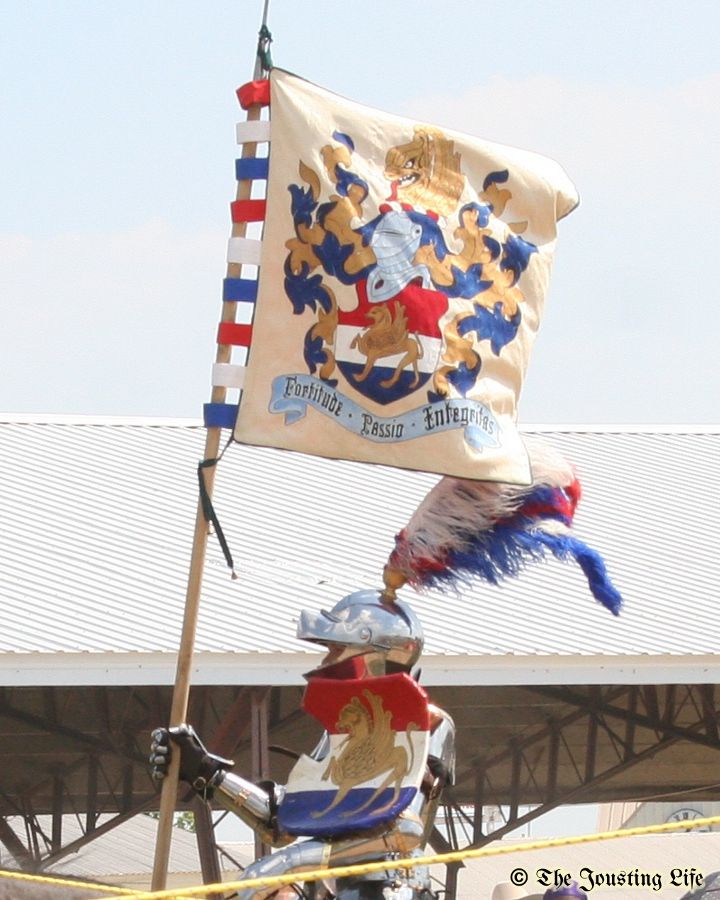
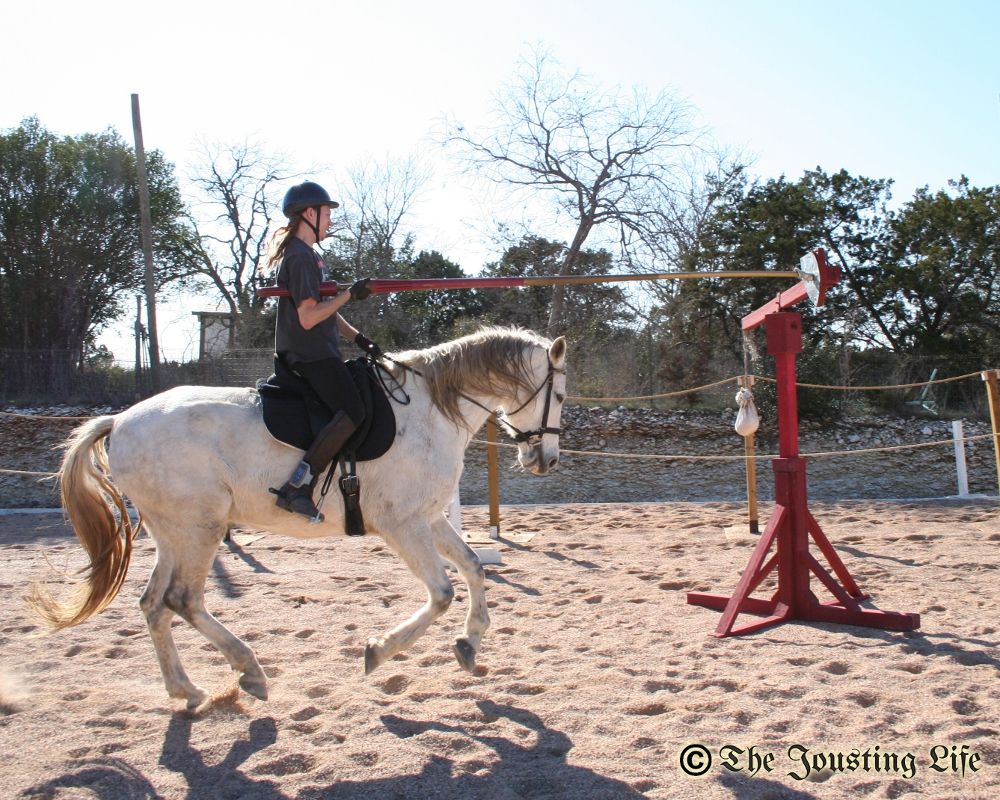
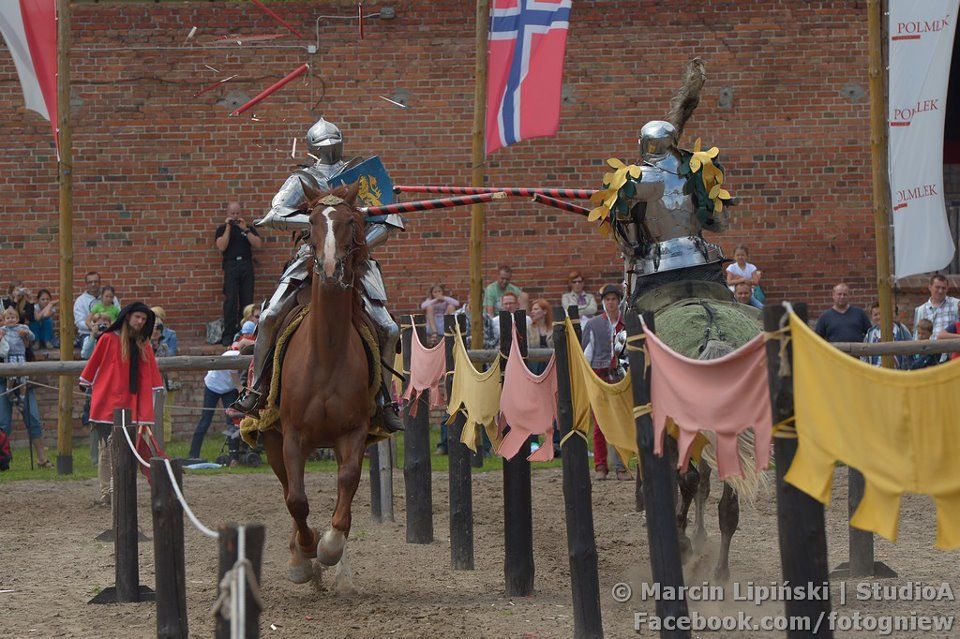
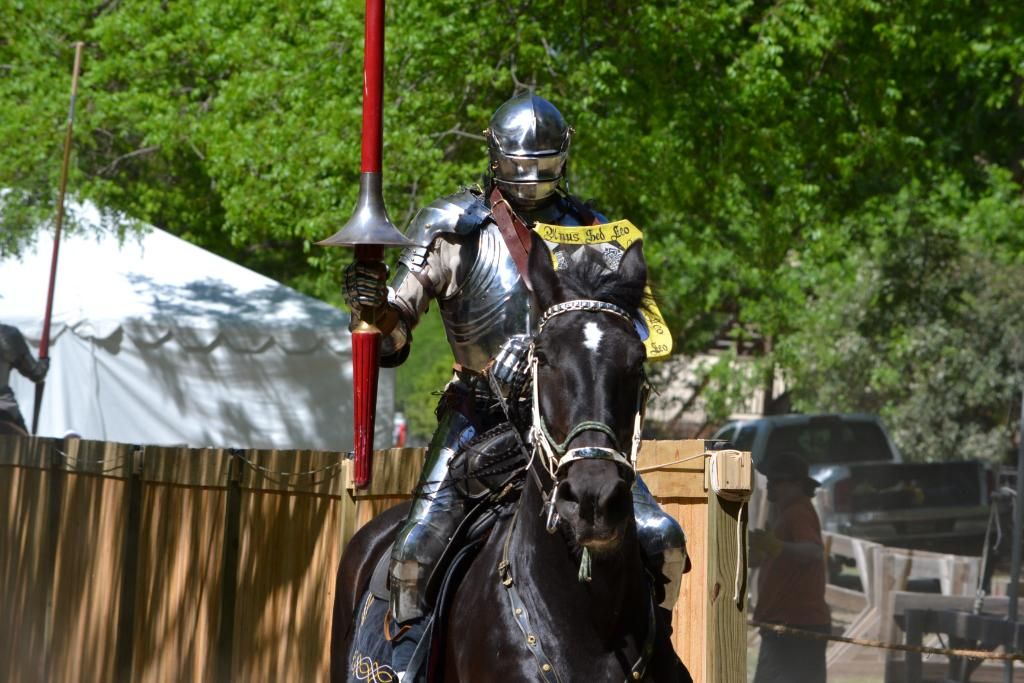
Interesting and informative. I am currently writing a short story about a knight, and a jousting tournament is included in the storyline, so this article has provided me with some useful information. Thank you.
ReplyDeleteShould you feel find it difficult to, you undoubtedly is not able to; If you don't intend, to have failing. Things are subject to intellect, reduction of hundreds exercises are hopeless prior to starting. hoc tu vung tieng anh
ReplyDeleteI wanted to thank you for this great read!! I definitely enjoying every little bit of it I have you bookmarked to check out new stuff you post. visum indien
ReplyDeletenice post, keep up with this interesting work. It really is good to know that this topic is being covered also on this web site so cheers for taking time to discuss this! New Zealand ETA
ReplyDeleteTo assist dissertation web sites over the web in case you get naturally released as part of your web site.lifeguard certification
ReplyDeleteYou can find dissertation online sites from the web make your home pickup unsurprisingly referred to in your ınternet sites. lifeguard training
ReplyDeleteThis is a smart blog. I mean it. You have so much knowledge about this issue, and so much passion. You also know how to make people rally behind it, obviously from the responses. florarie florisis
ReplyDeleteCemap.icu is a game-changer! The flashcards were a lifesaver, making revision a breeze. It's amazing that such a resourceful platform is available for free. Kudos to the team behind it!"
ReplyDeleteThis article is an excellent resource for expanding our knowledge and provides significant benefits. We appreciate you for sharing such valuable content.indian evisa
ReplyDelete"It continues to be crucial to highlight the truly exceptional nature of this post. My heart is brimming with gratitude for the remarkably outstanding content you've shared, which greatly enriches our collective knowledge. IPIO card holders � OCI in Lieu of PIO .
ReplyDeleteI like this web blog very much, Its a rattling nice post to read and find in
ReplyDeleteSolid Silver Diamonique Necklace https://thesparkleplace.com/
This awesome post. keep the work ahead. ling distance moving service!
ReplyDeleteI appreciate your in-depth exploration of the 'satta' culture. It's a dynamic world, and I'm working on optimizing my site to cover various aspects of 'satta.' Do you have any suggestions for effective keyword usage in this niche?satta king
ReplyDeleteThe more helpfully you can shop the most recent ladies funny trending t-shirt absent a lot of problem. The choices are enormous it is simply to keep the style necessary to the character in light of the fact that the funny trending t-shirts has a cool plan engraved to gives a cool appearance to the equivalent.
ReplyDeleteappreciate the historical context provided in this blog post. Understanding the origins of Sattaking! adds a whole new layer of appreciation for the game. Looking forward to exploring its modern iterations!
ReplyDeleteTraveling
ReplyDeleteTraveling
can be one of life's greatest adventures Whether you're exploring new cultures, tasting exotic cuisines, or marveling at breathtaking landscapes, every journey holds the promise of discovery and wonder. From bustling cities to serene natural wonders, there's a whole world out there waiting to be explored. So pack your bags, embark on new adventures, and make memories that will last a lifetime 🌍✈️
Traveling is a transformative experience that broadens horizons, fosters personal growth, and deepens our understanding of different cultures and ways of life. It offers the opportunity to explore new environments, try diverse cuisines, and meet people from various backgrounds, enriching our perspectives and creating lasting memories. Travel can also provide a break from the routine, rejuvenating the mind and spirit. However, it's important to travel responsibly, being mindful of environmental impacts and respecting local customs and communities. Sustainable travel practices ensure that the benefits of travel can be enjoyed by future generations while preserving the natural and cultural treasures of our world.
ReplyDeleteOne of the things I admire most about sports
ReplyDeleteis the way they teach us important life lessons. Whether it's learning to deal with defeat gracefully or working as a team towards a common goal, the skills we develop on the field often translate into success off the field as well
Cricket
ReplyDeleteis a bat-and-ball game that originated in England and has become one of the most popular sports in the world, particularly in countries like India, Australia, England, South Africa, Pakistan, and the West Indies. Here are some key points about the sport:
A Dictionary of Jousting Terms is essential for enthusiasts wanting to understand the sport's rich vocabulary. To celebrate this passion, consider using embroidery digitizing services to create custom merchandise featuring jousting terms and designs. Embroidered patches or apparel can showcase your love for the sport while promoting its historical significance.
ReplyDelete"A Dictionary of Jousting Terms" is a fascinating guide to the language and terminology associated with the medieval sport of jousting. Whether you're a history buff or a fan of medieval reenactments, this dictionary provides valuable insight into the practices and traditions of jousting. Similarly, choosing elfliq e liquid offers a flavorful and enjoyable experience for those who appreciate quality, providing a modern twist to an age-old tradition of satisfaction. Both delve into specialized knowledge for enthusiasts seeking the best in their interests
ReplyDelete"A Dictionary of Jousting Terms" is a fascinating resource for those interested in the history and terminology of medieval combat. Similarly, platforms offering Best Quran Reciter with Tajweed provide a detailed guide for learners to master the art of Quranic recitation with accuracy and understanding. Both are invaluable for anyone seeking to improve their knowledge and skills in their respective fields.
ReplyDelete
ReplyDeleteCổng Game Bài Đổi Thưởng Uy Tín Việt Nam mang đến trải nghiệm chơi game trực tuyến đa dạng và hấp dẫn. Với hệ thống bảo mật cao, rút tiền nhanh chóng và hỗ trợ nhiệt tình, đây là lựa chọn lý tưởng cho người chơi yêu thích cá cược online.
Địa chỉ: 77 Tên lửa, P.Tân Tạo, Q.Bình Tân, HCM
Game Bài Đổi Thưởng
Cổng Game Bài Đổi Thưởng Uy Tín Việt Nam mang đến trải nghiệm chơi game trực tuyến đa dạng và hấp dẫn. Với hệ thống bảo mật cao, rút tiền nhanh chóng và hỗ trợ nhiệt tình, đây là lựa chọn lý tưởng cho người chơi yêu thích cá cược online
ReplyDeletehttps://danhbaidoithuong.onl/
"A Dictionary of Jousting Terms" is a fascinating read for anyone interested in the sport's history and terminology! Just like jousting requires skill and precision, industries also depend on high-quality equipment to maintain efficiency. For example, Food Processing Machinery USA provides reliable machines that ensure food production is effective and precise. If you're looking to enhance your food processing solutions, check out this valuable resource:
ReplyDeleteFood Processing Machinery USA. Precision is key in both jousting and industry!"
"도박꾼 카지노 커뮤니티 Best Casino Community Gamblers 카지노커뮤니티 Best Casino Community Gamblers"
ReplyDelete"도박꾼 카지노 커뮤니티 Best Slot Community Gamblers 슬롯커뮤니티 Best Casino Community Gamblers"
ReplyDelete